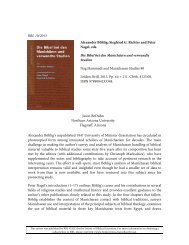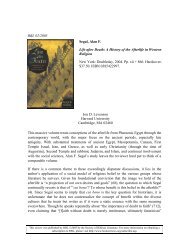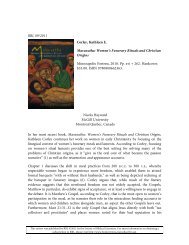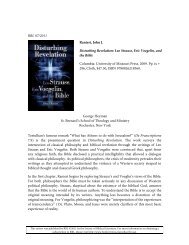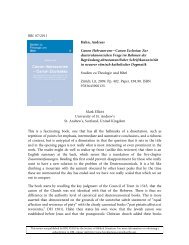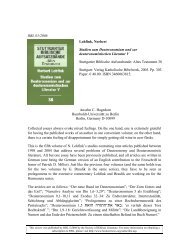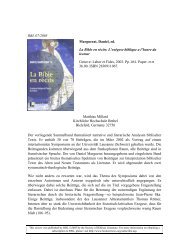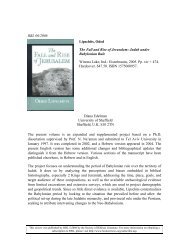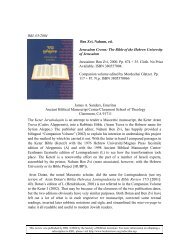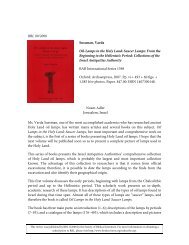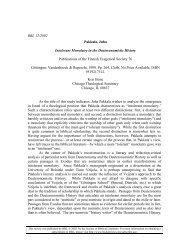RBL 09/04/2000 Gleis, Matthias. Die Bamah Beihefte zur Zeitschrift ...
RBL 09/04/2000 Gleis, Matthias. Die Bamah Beihefte zur Zeitschrift ...
RBL 09/04/2000 Gleis, Matthias. Die Bamah Beihefte zur Zeitschrift ...
You also want an ePaper? Increase the reach of your titles
YUMPU automatically turns print PDFs into web optimized ePapers that Google loves.
<strong>RBL</strong> <strong>09</strong>/<strong>04</strong>/<strong>2000</strong><br />
<strong>Gleis</strong>, <strong>Matthias</strong>.<br />
<strong>Die</strong> <strong>Bamah</strong><br />
<strong>Beihefte</strong> <strong>zur</strong> <strong>Zeitschrift</strong> für die alttestamentliche Wissenschaft 251<br />
Berlin: Walter de Gruyter, 1997. Pp. x + 291, Cloth, DM 168,00, ISBN 3110156903.<br />
W. Boyd Barrick<br />
2610 Glenwood Lane<br />
Billings, MT 59102<br />
Until now, the only monograph on the “high-place” (hereinafter “bamah”) question was<br />
P. H. Vaughan’s The Meaning of "ba4ma=" in the Old Testament (SOTSM 3; Cambridge:<br />
Cambridge University Press, 1974). Vaughan sought to demonstrate the familiar<br />
proposition that a bamah, sensu stricto, was some sort of raised cultic podium (e.g., an<br />
altar), and more generally a sanctuary, typically open-air, with or without a bamahpodium.<br />
His conclusions relied overmuch on archaeological materials to amplify the<br />
biblical evidence and, despite some valuable insights, his treatment of the Hebrew texts<br />
was superficial, thinly documented, and methodologically uneven. Over the last twenty<br />
years others also have addressed the question and some (including this reviewer) have<br />
begun to challenge the traditional views on the subject, but it would be premature to view<br />
them as harbingers of a new consensus. J. A. Emerton’s recent survey of “The Biblical<br />
High Place in the Light of Recent Study” (PEQ 129 [1997] 116-32) concludes, “The Old<br />
Testament tells us much about ba4ma=, but a precise definition eludes us. We do not know<br />
whether the word could be used of any local sanctuary, or whether there was something<br />
that differentiated ba4mo=t from other sanctuaries.” M. <strong>Gleis</strong>’s weighty new study is,<br />
therefore, a most welcome, timely, and significant contribution. As is to be expected from<br />
a revised dissertation (Tübingen [H. Niehr], 1996), there is an extensive critical<br />
Forschungsgeschichte (ch. 1) and bibliography (pp. 261-91, comprehensive into 1995).<br />
There are too many minor typographical errors for the price and, regrettably, there are no<br />
indices.<br />
The most vulnerable aspect of the proposition that a bamah was a cultic podium is the<br />
necessary assumption that a “bama,” sensu stricto, got its name because the root BMH<br />
has something to do with the concept of elevation. <strong>Gleis</strong> correctly rejects this “root<br />
fallacy” (“der Aspekt der Erhebung oder Höhe spielt in der biblischen Charakterisierung<br />
dagegen keine Rolle” [p. 246; cf. pp. 25-26]; he also resists the alluring Bronze Age<br />
structures that so captivated Vaughan (and a great many others, deeming them irrelevant<br />
for a consideration of a phenomenon known to have existed only in the Iron Age, and<br />
This review was published by <strong>RBL</strong> © <strong>2000</strong> by the Society of Biblical Literature. For more information on obtaining a<br />
subscription to <strong>RBL</strong>, please visit http://www.bookreviews.org/subscribe.asp.
opts instead for a literature-sensitive approach (see pp. 24-25). He begins promisingly<br />
with a discussion of the occurrence of the word in the Mesha Inscription (KAI 181.3-4)<br />
and concludes that it refers to a “königliches Heiligtum” and is semantically comparable<br />
to Heb. he=ka4l (ch. 3 and p. 252). But from his subsequent consideration of the biblical<br />
material (chs. 4-6) he concludes that an Israelite/Judahite bamah was the sanctuary of a<br />
village or town (“Ort,” for (i=r), located either inside the enclosure wall (see 1 Sam 9:13-<br />
14; cf. 10:5 [pp. 34-46]) or in the near vicinity outside, which served the various socioreligious<br />
needs of the residents of the place. It belongs entirely to the realm of local or<br />
“popular” religiosity (“Ortsreligion”/“Lokalkultes”), unrelated to the state-sponsored<br />
cultus in Jerusalem and uninteresting to Judahite kings before Josiah. It typically was<br />
famished with an open-air altar for burnt offerings, cultic statuary probably set up in a<br />
shrine or naos (=hamma4n?), and sometimes utilitarian structures<br />
(“Nebengebänden”=lis]ko=t [1 Sam 9:22-24]); the personnel that serviced it could be few<br />
or many, specialists or generalists, depending on the size and status of the installation and<br />
its “Ort” (cf. pp. 223-33). Although a bamah could be a sizable architectural complex, it<br />
cannot be regarded as a temple where (lh-offerings, not mentioned in conjunction with<br />
bamoth (notwithstanding 1 Kgs 3:4 [cf. pp. 198-99, 205-8]), were presented. Mesha’s<br />
“bamah” is thus the Transjordanian exception to the Cisjordanian rule. This too is a<br />
familiar proposition, but skillfully advanced and with many valuable observations along<br />
the way.<br />
The chief methodological problems in explicating the bamah phenomenon are to<br />
distinguish materials reflecting “ideological” conceptions (<strong>Gleis</strong> identifies the<br />
“deuteronom[ist]ic,” the Ezekielian, and the Chronicler’s) from those giving more<br />
“reportorial” information (the Mesha inscription being the parade example), and then to<br />
determine what (if anything) teamed from the former warrants the credibility accorded<br />
that learned from the latter. <strong>Gleis</strong> is sensitive to this problem and correctly recognizes a<br />
chronological trajectory toward generalization in the material, but in the end his picture<br />
of the OT bamah is very much like that of the “deuteronomists” (but without its<br />
theological baggage). Of this I am skeptical. Some of the conceptions assumed to be<br />
“deuteronom(ist)ic” are not credible. Thus for <strong>Gleis</strong>, the expression ba4te=-habba4mo=t is a<br />
“künstliche” rhetorical neologism (distinguishing northern bamoth from those in Judah)<br />
that sheds no light on the historical bamoth of the biblical period (pp. 48, 115-16, 248);<br />
perhaps so, and this would not be a unique case (cf., e.g., the association of childsacrifice<br />
with bamoth only in “spätdtr. Tradition” [p. 248 n. 11; cf. pp. 208-12]), but I<br />
suspect that more of the biblical picture of the bamah phenomenon than <strong>Gleis</strong> allows<br />
should be distilled in this way. The dross, rather than complete invention may have a<br />
basis in a different historical reality (as is probably true of the child-sacrifice references<br />
and perhaps also ba4te=-habba4mo=t [cf. bt. bmt in KAI 181.27]) which came to be associated<br />
with the bamah phenomenon secondarily as ba4ma= became something of a portmanteau<br />
word for any site of unsavory or objectionable cultic activity.<br />
This review was published by <strong>RBL</strong> © <strong>2000</strong> by the Society of Biblical Literature. For more information on obtaining a<br />
subscription to <strong>RBL</strong>, please visit http://www.bookreviews.org/subscribe.asp.
The term ba4ma= itself is not a neologism, “deuteronom(ist)ic” or otherwise, but is drawn<br />
from the vocabulary of cultic architecture used in IA Palestine. <strong>Gleis</strong>’s picture of a bamah<br />
summarized above would also describe, architecturally, the Temple in Jerusalem, at least<br />
in the time of Josiah (2 Kgs 23:4-14); using a similar model, J. Lindblom once observed<br />
that “Solomon’s sanctuary, on its hill, was a bamah, but in the form of a great temple<br />
building” (Israels Religion i Gammaltestamentlig Tid [3rd edn.; Stockholm:<br />
Diakronistrelsens, 1964] 99-100 [my translation]). As what looks, walks, and sounds like<br />
a duck probably belongs to the species duck, what looks like a bone fide “temple” (he=ka4l,<br />
bayit) probably belongs to that architectural species, notwithstanding the ideological<br />
proposition that there cannot have been more than Solomon’s. As a practical matter, what<br />
would be the physical, architectural difference between a sanctuary where (lh-offerings<br />
were presented and one where (only?) zbh[-offerings were? What did the Judahite soldiers<br />
and bur bureaucrats stationed at Arad and unschooled in “deuteronom(ist)ic” vocabulary<br />
call the manifestly temple-like cultic installation that they certainly patronized there (cf.<br />
too the unseen sanctuary inside Lachish from which the large vessels carried by the<br />
Assyrian in the reliefs were looted)? The word (i=r, in itself ambiguous (cf. pp. 55-61), is<br />
used to describe the “city” (“Stadt”) of Jerusalem (also Lachish, Gibeon, and other<br />
sizable population centers), and to downgrade the reference to a “village/town” when a<br />
bamah is mentioned amounts to special pleading; the “(ir” described in 1 Sam 9:5-10:9<br />
(whatever its actual identity) looks to me more like one of the small walled and gated<br />
“cities” known archaeologically in the region from IA II, when <strong>Gleis</strong> claims the story<br />
originated, than the tiny “villages” (better, “compounds”) of IA I, when the episode the<br />
story tells supposedly happened. Mesha called his sanctuary on the acropolis of Dibon<br />
(surely a “Stadt” [cf. 2 Kgs 3:25-27]), the functional equivalent of Solomon’s in<br />
Jerusalem, a “bamah” and presumably so too did his subjects. The presumption ought to<br />
be that Heb. ba4ma= designated something recognizably similar in the vocabulary of IA<br />
Judahites (cf. pp. 63-8) and that the association of bamoth with village life is a secondary<br />
rhetorical (and exegetical) development. On this important point <strong>Gleis</strong> may have been too<br />
accepting of the received tradition, biblical (cf. p. 23) and scholarly.<br />
This is an important new sifting of the available evidence and will satisfy many. <strong>Gleis</strong> is<br />
to be commended for presenting the status quaestionis so very well in what surely will<br />
supplant Vaughan’s vastly inferior study as the standard work—although probably not<br />
the last word—on the subject.<br />
This review was published by <strong>RBL</strong> © <strong>2000</strong> by the Society of Biblical Literature. For more information on obtaining a<br />
subscription to <strong>RBL</strong>, please visit http://www.bookreviews.org/subscribe.asp.



